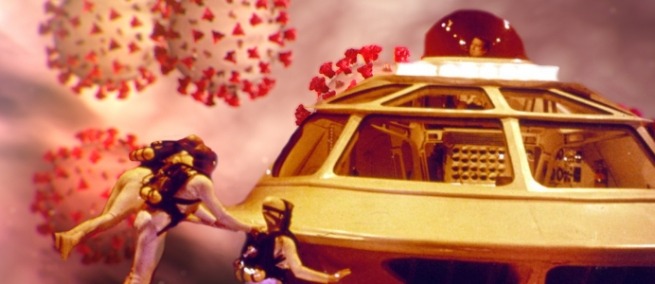
Hollywood and the Centers for Disease Control and Prevention have faced similar challenges in visually representing microscopic threats to the human body. The iconic sci-fi film FANTASTIC VOYAGE (1966) and the ubiquitous 2019 illustration of COVID-19 both render elusive yet life-threatening ailments.
The Academy Award-winning FANTASTIC VOYAGE, directed by Richard Fleischer, is a landmark for its depiction of the body and its interior. Starring Raquel Welch and Donald Pleasence, FANTASTIC VOYAGE imagines a future in which medical technicians literally enter the body to treat illness; they are shrunk and injected into a dying scientist who knows Cold War military secrets, in order to annihilate a blood clot situated in an inoperable area. Nanorobots and laparoscopic cameras can now enter these inner realms, so Fantastic Voyage remains intriguing for the prescience of its cinematic vision. Medical illustration, like special effects, can present an aestheticized image with the unique capacity to capture the imagination, as well as to inform and educate. In 2020 the spiky blob—the illustration of the SARS-CoV-2 virus that causes COVID-19—has become an iconic image associated with the current pandemic, more prevalent and provocative than any direct technological visualization of the virus.
On June 25, Museum of the Moving Image’s Science on Screen series is thrilled to welcome CDC medical illustrator Alissa Eckert, the person responsible for creating the image of the spiky blob, for a conversation and Q&A, including clips and images, with science and technology scholar and author David Serlin (Imagining Illness: Public Health and Visual Culture). The conversation, moderated by Science on Screen curator Sonia Epstein, will consider illustration and visualization, public education and accessibility, and the development of the image of COVID-19.
In advance of the conversation, we encourage you to watch FANTASTIC VOYAGE, which can be rented from these platforms.
TOPICS